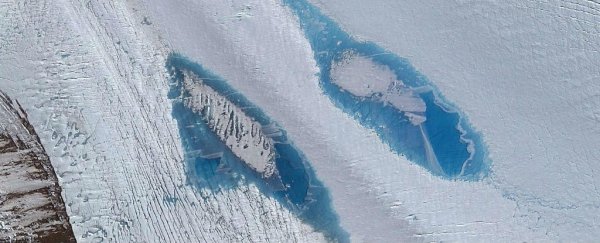Scientists have confirmed that thousands of pristine blue lakes have appeared on the ice sheets of East Antarctica, and it's got them very worried.
The problem? They've seen this kind of thing happen before. Greenland's ice sheet has been disintegrating rapidly, losing a whopping 1 trillion tonnes of ice between 2011 and 2014, and research suggests it's because of these lakes.
A team of UK researchers has analysed hundreds of satellite images and meteorological data taken of the Langhovde Glacier in East Antarctica, and found for the first time that between 2000 and 2013, nearly 8,000 of these lakes had formed.
Some of these formations, known as supraglacial - or meltwater - lakes, appear to be draining into the floating ice below, which could have serious consequences for the stability of the entire ice shelf.
Ice shelves are thick, floating slabs of ice that form where a glacier or masses of ice flow down a coastline, whereas an ice sheet is a massive chunk of glacier ice covering an area of land greater than 50,000 square kilometres (20,000 square miles).
What's strange about this news is the fact that researchers had assumed that East Antarctica was fairly impervious to rising climate and ocean temperatures, and have instead been focussing their efforts on investigating the Antarctic Peninsula.
The Antarctic Peninsula is the northernmost part of the mainland of Antarctica, and has shown signs of rapid atmospheric and ocean warming in recent years.
The disintegration of the East Antarctic ice sheet, on the other hand, has been more subtle, and now researchers are concerned that our lack of knowledge on how supraglacial lakes are affecting it will impact our ability to predict the consequences.
"[East Antarctic is] the part of the continent where people have for quite a long time assumed that it's relatively stable," one of the team, glaciologist Stewart Jamieson from Durham University, told Chris Mooney at The Washington Post.
"There's not a huge amount of change, it's very, very cold, and so, it's only very recently that the first supraglacial lakes, on top of the ice, were identified."
As Mooney explains, as the air temperatures rise during the summer months, these supraglacial lakes form on the surface of the ice sheets, and on the slender glaciers that stretch out into the ocean.
These lakes don't last long - they either disappear through refreezing (the best option), drain vertically through the floating ice, or overflow into rivers on the surface that drain into the ice below.
These last two options have been shown in Greenland's case to eat away at and weaken the structure of the ice sheets and ice shelves, hastening their own disintegration.
"Sometimes, researchers have even been able to document fresh water flowing outward directly into the sea from the base of a glacier," Mooney says.
"That injection of cold fresh water into salty water can then create tornado-like underwater flow patterns at the submerged glacier front that cause further ice loss."
So why did thousands of these things suddenly appear in East Antarctica over the course of just three years? You guessed it - climate change.
The team found that over the 13-year period they studied, the warmest (Southern Hemisphere) summer was between 2012 and 2013, with a total of 37 "positive degree days", and a mean daily surface air temperature of 0.8 degrees Celsius in January.
For comparison, the 2007/2008 summer had just five positive degree days and a mean daily surface air temperature of -1.8 degrees Celsius in January.
During this 2012/2013 summer, Langhovde's glacier surface experienced 36 percent more new lakes and surface channels overspilling than ever before.
"What we find is that the appearance of these lakes, unsurprisingly, is correlated directly with the air temperature in the region, and so the maximum number of lakes, and the total area of the lakes, as well as the depth of the lakes, all of these things peak when the air temperatures peak," Jamieson told The Washington Post.
The researchers aren't ready to call this the beginning of the end of the East Antarctic ice sheet just yet, saying that if things stayed as they are, we wouldn't have much to worry about.
But with July 2016 being confirmed as the world's hottest month since records began, and the 10th consecutive month of record-breaking heat across the globe, historic levels of rising temperatures are something we're going to have to get used to, and that could mean more and more supraglacial lakes.
"The size of the lakes … are probably not big enough to do much at present, but if climate warming continues in the future, we can only expect the size and number of these lakes to increase. So that's what we're looking at," Jamieson says.
At least some corals will be happy.
The study has been published in Geophysical Research Letters.
